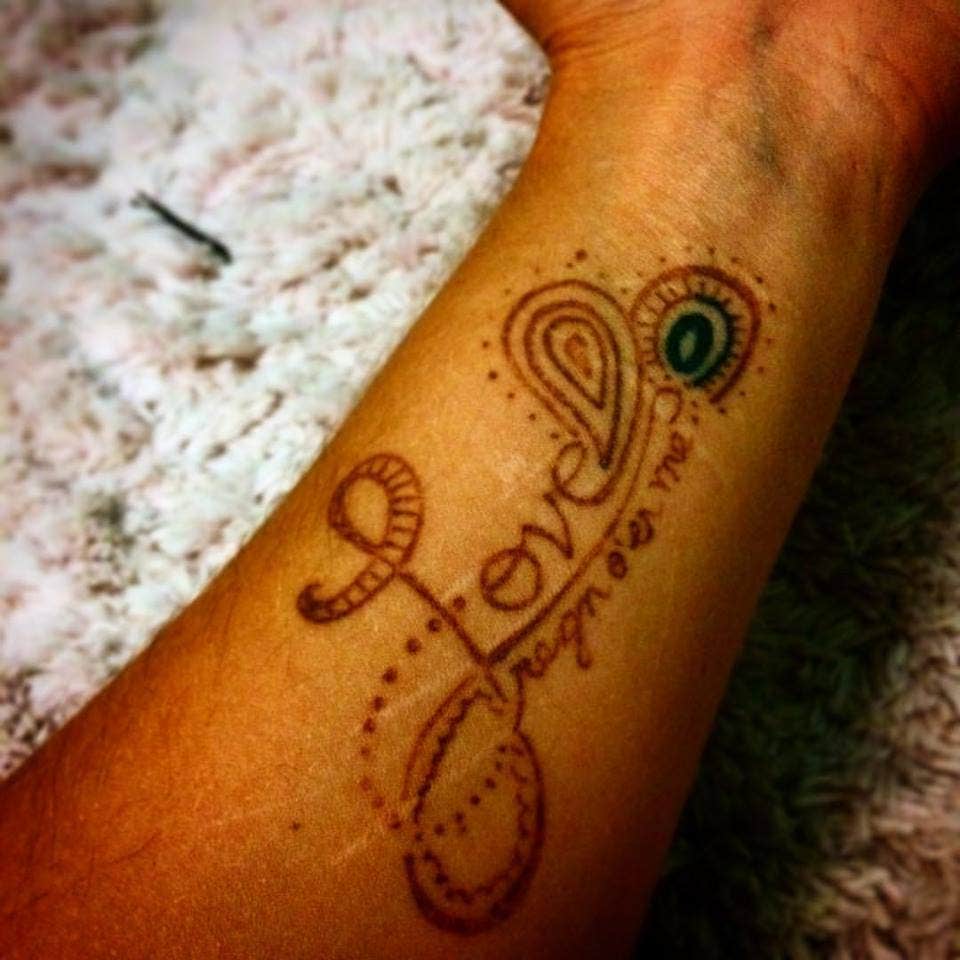How My Tattoo Saved Me From A Life Of Self-Harm
I have zero shame in stating that a tattoo is presently responsible for saving me from myself.
 pio3 / Shutterstock
pio3 / Shutterstock The first time I cut myself, I didn't even realize I was doing it. I was at a high school party with one of my favorite people, whose effortless brand of "Naturally Glamorous with a Heavy Dose of Irreverent Wit" had once again commanded the attention of everyone in the room.
She was effervescent, her big brown eyes sparkling with every brilliant joke she landed, and with her naturally tiny frame and wavy blonde hair she took over as Unofficial Life of the Party.
Unfortunately, my rampant adolescent insecurity wouldn't allow me to enjoy any of it. Feeling invisible, I steeped in self-loathing on a couch in the corner, where I began mindlessly dragging my car keys across my forearm.
I didn't notice I'd been hurting myself until we were walking back to my car hours later. I was angrily projecting my self-hatred onto my friend when I looked down and saw that my skin was dotted with indentations and scratches that oozed blood. I was startled. I couldn't explain why I'd unconsciously done that, but I brushed it off as being something minor, maybe perpetrated by the two beers I'd had.
At 16, I'd been dealing with depression and suicidal ideation for years, but they'd only ever manifested in terrible poetry and poor romantic decisions. Cutting wasn't yet a social trend and not anything I'd been exposed to firsthand, even though my friends and I were candid about discussing our varied mental struggles.
However, being that my depression was out of control, it wasn't long before I started relying on little cuts or burns to help me cope with the moments my despair seemed insurmountable. The sting provided a rush of relief, and I got hooked on the pleasurable endorphins that followed my attacks (as evidenced by photos of me wearing long sleeves and jeans year-round, even though I lived at the beach).
For the next decade, I compulsively inflicted pain in my darker moments, carving increasingly deeper wounds all over my body with sharper, hotter tools when my life began to spiral downward. This secret ritual provided a bizarre sense of control and comfort during a time when I felt neither.
Even when I was hospitalized for a suicide attempt in my early 20s and was stripped of anything potentially dangerous, I clawed at my forearms until they were raw and gently bled.
I'd put out my rationed cigarettes on my Achilles heels, and peeled away a corner of the vinyl laminate on the dresser by my hospital bed to make tiny cuts in my inner thighs at night. The familiar pain calmed my anxiety enough for me to sleep on the crunchy, sterile mattress.
Despite working diligently through 12 years of therapy and taking closely-monitored psychiatric medications, my self-harm habit stayed with me like a security blanket. I never planned to let go of it.
But when I turned 30, I realized I needed to be proactive about moving forward in recovery, lest I waste my life perpetuating my misery by forever identifying as a victim. I'm the type of person who needs her symbolism to be literal, so I commissioned my best friend to create a tattoo for my left forearm, the place where my self-mutilation had always started and was usually focused.
I wanted more than just a symbolic icon; I needed artwork that would act as a protective barrier between my body and my bad habits.
I chose the phrase "Love, reign o'er me," — those with great taste will recognize as lyrics by The Who — and my friend embellished it perfectly to cover my most prominent laceration scars.

Photo: Author
It worked.
The first few times I felt that old compulsion to begin cutting myself, the tattoo stopped me in my tracks.
Instinctively, I'm protective of artwork by someone I adore, but being that this was created by a loved one for the express purpose of reminding me that I, too, am always loved, reduced me to tears, as I realized what I'd be doing by damaging it. Rereading the quote emblazoned on my wrist, I decided that repeating this mantra is now my new coping mechanism.
"Love, reign o'er me."
I say it daily, sometimes when I feel worthless and suicidal, and other times when I want to lash out at humanity. Asking "Love" to take over my motivations has never instantly transformed me into a gentle saint, but its effects have slowly become more evident.
I used to crave the feeling of self-inflicted pain at least a few times weekly, but in the last two years since I got inked, this mental hang-up has diminished. Now, I only struggle to fight the urge every few months. This, to me, is an entirely new lifestyle.
But the miracle is that, no matter how many times the compulsion to self-harm has presented itself since I got my Art Shield, I haven't given into it. Not once. Not on any part of my body.
I don't care if this "tattoo healing method" of mine is just a placebo effect in action. I'm aware that a self-mutilation compulsion is, incidentally, "all in my head," so if the only way for me to block it is by countering with a stronger mental barrier, then I'm delighted to implement it.
I have zero shame in stating that a tattoo is presently responsible for saving me from myself. And honestly, I can't think of a better use of art than to defeat mental demons, regardless of the medium.
Liz Pardue-Schultz is a writer and activist. Her words have appeared in Huffington Post, Time, Ravishly, and ThoughtCatalog.

